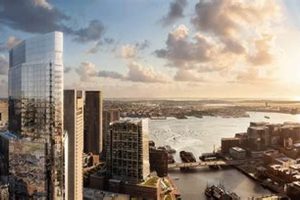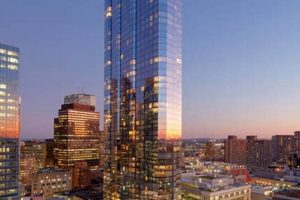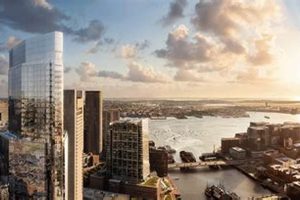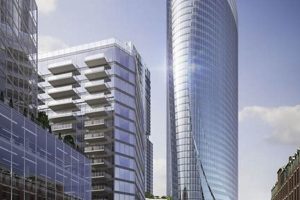A skyscraper is a continuously habitable high-rise building having multiple floors. They house a large amount of floor area, making them efficient for housing large numbers of people or accommodating diverse activities. Skyscrapers are iconic urban landmarks and symbols of economic prosperity and technological advancement. The first skyscrapers were built in the late 19th century in Chicago and New York City.
Skyscrapers offer several advantages. They maximize land use in densely populated urban areas and provide convenient access to various amenities and transportation hubs. Moreover, skyscrapers can be engineered to withstand various environmental factors, including wind, earthquakes, and fires, making them safe and habitable.
In the following sections, we will delve deeper into the history of skyscrapers, their design and construction techniques, and their impact on urban development. We will also explore the architectural innovations and engineering marvels that have shaped these iconic structures.
1. Height
In exploring “what is a skyscraper,” height stands as a defining characteristic, a testament to human ambition and architectural prowess. Skyscrapers soar beyond mere structures; they are vertical cities, reshaping urban landscapes and skylines. Their height unlocks unique advantages and challenges, shaping their design, engineering, and impact.
- Vertical Space Utilization: Skyscrapers maximize land use in densely populated urban areas, accommodating vast amounts of floor space within a limited footprint.
- Engineering Marvels: Achieving remarkable heights requires innovative engineering solutions to overcome wind forces and structural stability challenges.
- Urban Landmarks: Skyscrapers serve as iconic landmarks, defining cityscapes and becoming symbols of urban identity and economic prosperity.
- Architectural Statements: The height of skyscrapers provides a canvas for architectural expression, leading to visually striking and innovative designs.
The height of skyscrapers is not merely a physical attribute; it embodies the spirit of human ingenuity and the quest for upward growth. These towering structures are more than just buildings; they are testaments to our ability to innovate, engineer, and create architectural marvels that redefine our cities and inspire generations.
2. Floors
Floors are a fundamental aspect of skyscrapers, enabling them to accommodate a large number of people and activities within a limited footprint. Each floor adds valuable space, allowing skyscrapers to serve diverse functions, from residential to commercial to mixed-use developments.
The vertical stacking of floors maximizes land use, a crucial consideration in densely populated urban areas where land is scarce. By building upwards, skyscrapers create more usable space without sprawling outwards, preserving valuable ground-level space for parks, public areas, and other essential infrastructure.
Skyscrapers with multiple floors also offer practical advantages. They provide vertical transportation options such as elevators and stairs, allowing for efficient movement between floors. This vertical connectivity enhances accessibility and convenience for occupants, reducing travel time and congestion within the building.
Moreover, the division of a skyscraper into multiple floors enables flexible use of space. Different floors can be dedicated to specific purposes, such as residential units, office spaces, retail stores, or recreational facilities. This functional organization creates a diverse and dynamic environment within the skyscraper, accommodating a wide range of activities and user needs.
In conclusion, the multiple floors of a skyscraper are not simply a collection of horizontal surfaces; they are essential components that define the building’s functionality, space utilization, and overall impact on the urban environment.
3. Structure
The structure of a skyscraper is paramount to its existence and functionality. It is the backbone that enables these towering giants to withstand the forces of nature and provide a safe and habitable environment for their occupants. The sturdy framework of steel, concrete, or composite materials used in skyscraper construction ensures stability, allowing them to reach unprecedented heights and endure various environmental conditions.
Steel, with its exceptional strength-to-weight ratio, is a common choice for skyscraper structures. It can withstand immense tensile and compressive forces, making it ideal for constructing the skyscraper’s frame, columns, and beams. Concrete, known for its compressive strength and durability, is often used for the core and floor slabs of skyscrapers. Composite materials, combining the properties of steel and concrete, offer enhanced strength and flexibility, enabling architects and engineers to push the boundaries of skyscraper design.
The structural integrity of a skyscraper is crucial for its safety and longevity. It must be able to resist lateral forces such as wind and seismic activity, as well as vertical loads from its own weight and the weight of its occupants. Engineers employ various techniques to ensure stability, including the use of shear walls, outrigger systems, and tuned mass dampers. These structural elements help dissipate wind energy, reduce sway, and minimize vibrations, ensuring the comfort and safety of the building’s inhabitants.
In conclusion, the sturdy structure of a skyscraper is the foundation upon which its architectural marvels and functional capabilities rest. By understanding the importance of structural stability, engineers and architects can create skyscrapers that are not only visually impressive but also safe and sustainable for generations to come.
4. Design
The design of a skyscraper is not merely about aesthetics; it also encompasses functionality and reflects the creativity of architects. As skyscrapers push the boundaries of height and complexity, their design becomes increasingly important in ensuring structural integrity, optimizing space utilization, and creating visually appealing landmarks.
The choice of materials, the shape of the building, and the arrangement of its elements all contribute to the overall design of a skyscraper. Architects carefully consider factors such as wind resistance, seismic activity, and energy efficiency when designing these towering structures. They employ innovative engineering techniques and sustainable practices to create skyscrapers that
are both visually stunning and environmentally conscious.
The design of a skyscraper also plays a significant role in enhancing the quality of life for its occupants and the surrounding community. Natural light, ventilation, and views are important considerations that impact the well-being and productivity of people living and working in skyscrapers. Architects incorporate design elements such as large windows, open floor plans, and green spaces to create comfortable and healthy.
In conclusion, the design of a skyscraper is an integral part of “what is a skyscraper.” It goes beyond aesthetics to encompass functionality, structural integrity, and the well-being of its occupants. By understanding the connection between design and the essence of a skyscraper, we can appreciate the creativity and engineering prowess that goes into creating these architectural marvels.
5. Purpose
Understanding the purpose of a skyscraper is crucial to grasping its essence. Skyscrapers are not merely tall buildings; they are multifaceted structures that serve a wide range of functions, from providing residential spaces to housing commercial enterprises. This diversity of purpose is a defining characteristic of skyscrapers and shapes their design, construction, and impact on the urban environment.
Residential skyscrapers, also known as apartment buildings or condo towers, provide housing for thousands of people, offering a convenient and often luxurious urban lifestyle. These skyscrapers feature amenities such as fitness centers, swimming pools, and rooftop gardens, creating a sense of community and enhancing the quality of life for residents. Commercial skyscrapers, on the other hand, house offices, retail stores, and other businesses. They are often designed to accommodate large numbers of workers and customers, with efficient floor plans and advanced infrastructure to support their operations.
The diverse purposes of skyscrapers have a profound impact on urban development. Residential skyscrapers help address the housing needs of growing populations, especially in densely populated cities where land is scarce. Commercial skyscrapers, in turn, create job opportunities and contribute to the economic vitality of the city. By accommodating a wide range of activities within a single structure, skyscrapers promote mixed-use development and reduce urban sprawl, making cities more livable and sustainable.
In conclusion, the purpose of a skyscraper is an integral part of “what is a skyscraper.” It determines the building’s design, functionality, and impact on the urban environment. Understanding the diverse purposes of skyscrapers allows us to appreciate their value and the role they play in shaping our cities.
6. Engineering
Engineering plays a pivotal role in defining “what is a skyscraper.” Advanced engineering techniques are essential to overcome the unique challenges posed by a skyscraper’s height and the wind forces it encounters.
- Structural Systems: Skyscrapers employ innovative structural systems to withstand the immense weight of the building and the lateral forces of wind. These systems include reinforced concrete cores, steel frames, and outrigger trusses, which work together to distribute loads and prevent excessive sway.
- Wind Engineering: Understanding wind behavior is crucial for skyscraper design. Engineers conduct wind tunnel tests and use computational fluid dynamics to analyze wind patterns and design buildings that minimize wind resistance. This reduces structural stress and ensures occupant comfort.
- Materials and Construction: Skyscrapers utilize high-strength materials such as steel and concrete to achieve structural integrity. Advanced construction techniques, such as prefabrication and modular construction, enable efficient and accurate assembly.
- Seismic Design: In earthquake-prone areas, skyscrapers are engineered to withstand seismic forces. Base isolation systems, energy dissipation devices, and tuned mass dampers are employed to reduce vibrations and protect the building during earthquakes.
By overcoming these engineering challenges, skyscrapers can ascend to remarkable heights and provide safe and habitable spaces. These engineering marvels are a testament to human ingenuity and push the boundaries of architectural innovation.
7. Sustainability
Sustainability has become an integral part of modern skyscraper design as architects and engineers strive to minimize the environmental impact of these towering structures. Incorporating eco-friendly features is not merely an option but a necessity in today’s world, where climate change and resource depletion pose significant challenges.
The connection between sustainability and “what is a skyscraper” lies in the recognition that skyscrapers, with their massive scale and energy consumption, have a substantial environmental footprint. Sustainable practices aim to reduce this footprint by implementing energy-efficient systems, utilizing renewable energy sources, and employing sustainable materials throughout the building’s lifecycle.
Practical examples of sustainability in skyscrapers include:
- Energy-efficient lighting systems that use LED or natural light to reduce energy consumption.
- Green roofs that absorb rainwater, provide insulation, and create urban green spaces.
- Rainwater harvesting systems that collect and store rainwater for non-potable uses, reducing reliance on municipal water sources.
- Solar panels that generate renewable energy, reducing the building’s carbon footprint.
By incorporating these and other sustainable features, modern skyscrapers can significantly reduce their environmental impact. This not only benefits the environment but also aligns with the growing demand for green buildings from tenants, investors, and environmentally conscious consumers.
In conclusion, sustainability is an essential component of “what is a skyscraper” in the 21st century. By embracing eco-friendly practices, skyscrapers can minimize their environmental footprint, contribute to a greener urban environment, and meet the demands of a sustainable future.
8. Urban Impact
Skyscrapers’ impact on urban landscapes is a significant aspect of “what is a skyscraper.” These towering structures have the power to transform skylines, redefine neighborhoods, and serve as symbols of economic prosperity and urban development.
- Vertical Expansion and Land Use: Skyscrapers maximize land use in densely populated cities by building upwards, allowing for efficient utilization of limited space.
- Economic Hubs: Skyscrapers often house major corporations, financial institutions, and businesses, creating economic centers that drive urban growth and job creation.
- Cultural Landmarks: Iconic skyscrapers become
landmarks that define a city’s identity and attract tourism, contributing to the city’s cultural and architectural heritage. - Mixed-Use Developments: Modern skyscrapers often incorporate a mix of residential, commercial, and retail spaces, fostering vibrant and diverse urban environments.
These facets of urban impact highlight the significant role skyscrapers play in shaping the character and functionality of cities. They stand as symbols of human ambition, architectural ingenuity, and economic progress, leaving a lasting legacy on the urban landscape.
FAQs about Skyscrapers
Skyscrapers, with their towering heights and iconic presence, often spark questions and curiosities. Here are answers to some frequently asked questions that delve deeper into the world of skyscrapers:
Question 1: What is the primary purpose of a skyscraper?
Skyscrapers serve diverse purposes, primarily accommodating a large number of people and activities within a limited footprint. They house residential units, office spaces, retail stores, and various commercial establishments, creating vertical communities and maximizing land use in densely populated urban areas.
Question 2: What factors determine the height of a skyscraper?
The height of a skyscraper is influenced by several factors, including engineering capabilities, land costs, zoning regulations, and architectural design. Structural stability, wind resistance, and the availability of advanced construction technologies also play crucial roles in determining how high a skyscraper can be built.
Question 3: How do skyscrapers withstand strong winds?
Skyscrapers employ various structural systems to resist wind forces. These systems may include reinforced concrete cores, steel frames, and outrigger trusses, which work together to distribute wind loads and minimize sway. Additionally, wind engineering techniques are used to analyze wind patterns and optimize the building’s shape to reduce wind resistance.
Question 4: Are skyscrapers safe during earthquakes?
Modern skyscrapers are designed to withstand earthquakes through the implementation of seismic engineering principles. Base isolation systems, energy dissipation devices, and tuned mass dampers are employed to reduce vibrations and protect the building during seismic events. Regular inspections and maintenance also contribute to ensuring the safety of skyscrapers in earthquake-prone areas.
Question 5: How do skyscrapers contribute to sustainable urban development?
Sustainable skyscrapers incorporate eco-friendly features such as energy-efficient lighting systems, green roofs, rainwater harvesting systems, and solar panels. These features reduce energy consumption, minimize environmental impact, and create healthier indoor environments. Additionally, mixed-use skyscrapers promote walkability, reduce urban sprawl, and foster vibrant urban communities.
Question 6: What are some of the tallest skyscrapers in the world?
The Burj Khalifa in Dubai currently holds the title of the tallest building in the world, standing at 828 meters (2,717 feet). Other notable skyscrapers include the Shanghai Tower in China, the Makkah Royal Clock Tower in Saudi Arabia, and the One World Trade Center in the United States.
Summary:
Skyscrapers are marvels of engineering and architectural ingenuity, serving diverse purposes and shaping urban landscapes. Their construction and design are influenced by various factors, including structural stability, wind resistance, and sustainability. Skyscrapers continue to push the boundaries of innovation, offering unique solutions to the challenges of urban living and contributing to the economic and cultural vitality of cities.
Transition:
Having explored the essence of skyscrapers and addressed some common questions, we now move on to examining the design and construction aspects of these towering structures, uncovering the complexities and advancements that make skyscrapers possible.
Tips for Understanding “What is a Skyscraper”
To enhance your comprehension of skyscrapers, consider these informative tips:
Tip 1: Explore Diverse Purposes and Functions
Skyscrapers fulfill a wide range of purposes, including residential, commercial, and mixed-use developments. Understanding these diverse functions helps appreciate their impact on urban environments and the needs they address.
Tip 2: Analyze Structural Design and Engineering
Skyscrapers are marvels of engineering, employing innovative structural systems to withstand wind forces and seismic activity. Explore how these systems, such as reinforced concrete cores and outrigger trusses, contribute to the stability and safety of these towering structures.
Tip 3: Examine Sustainable Features and Eco-Friendly Practices
Modern skyscrapers incorporate sustainable features to reduce their environmental impact. Investigate how green roofs, energy-efficient lighting, and rainwater harvesting systems contribute to a greener urban environment.
Tip 4: Consider Historical Evolution and Architectural Styles
Skyscrapers have a rich history, evolving over time to reflect architectural styles and technological advancements. Explore the early skyscrapers of the late 19th century to the iconic structures of today, noting the changes in design and construction techniques.
Tip 5: Compare Different Skyscrapers Around the World
Skyscrapers vary in height, design, and purpose worldwide. Compare notable skyscrapers from different regions, examining their unique features and how they reflect the cultural and economic context of their location.
Summary:
By following these tips, you can gain a deeper understanding of “what is a skyscraper.” From their diverse functions to their innovative engineering and sustainable features, skyscrapers are fascinating examples of human ingenuity and architectural prowess. Exploring these aspects provides a comprehensive perspective on these iconic structures and their significance in shaping our urban landscapes.
Transition:
With a solid foundation in understanding skyscrapers, we can now delve into the captivating world of their design and construction, uncovering the intricacies and advancements that make these towering structures possible.
Conclusion
Our exploration of “what is a skyscraper” has unveiled the multifaceted nature of these architectural marvels, which transcend mere structures and become symbols of human ambition and urban progress. We have journeyed through the diverse purposes they serve, from providing residential spaces to housing commercial enterprises. We have examined the engineering ingenuity that enables skyscrapers to reach unprecedented heights and withstand the forces of nature. We have also highlighted the growing emphasis on sustainability, as modern skyscrapers incorporate eco-friendly features to minimize their environmental impact.
Skyscrapers continue to push the boundaries of innovation, serving as testaments to our ability to design and construct remarkable structures that reshape our cities and skylines. As we look to the future, we can anticipate even more advancements in skyscraper design and construction, driven by a to create sustainable, resilient, and awe-inspiring architectural icons that meet the evolving needs of our urban environments.







